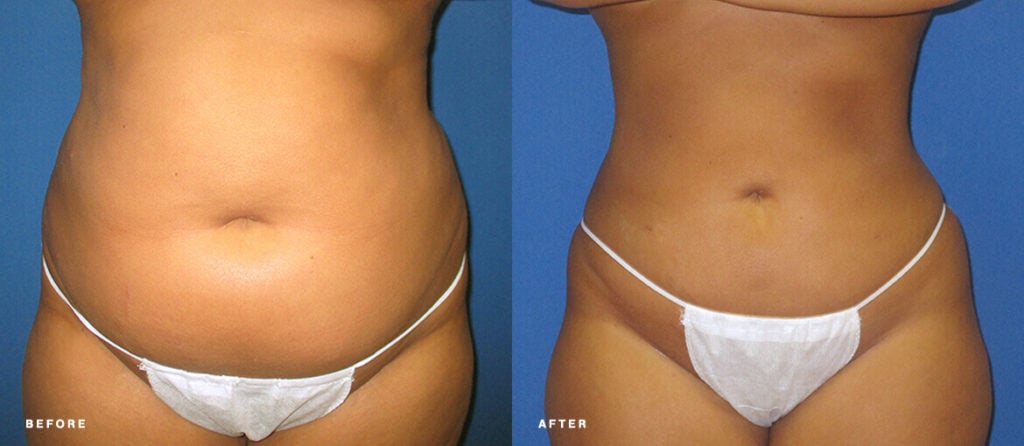
Medically reviewed by Dr. John Rosdeutscher – Written by Sine Thieme
Is Liposuction Safe?
As with any surgical procedure, you will have to decide whether the benefits to your well-being outweigh the risks of liposuction. Prior to your liposuction procedure, your doctor will ask you to sign a consent document that details all known liposuction complications and risks. We are guessing you’d prefer to read about these in plain English rather than lawyer-speak. This article, prepared by our NuBody Concepts Cosmetic Surgery staff in Nashville and Memphis, TN, will give you a brief overview.
Before we get into specific risks, we’d like to point out that according to the American Society of Plastic Surgeons, liposuction is the second most popular cosmetic plastic surgery procedure in the United States (and has been for many years.) Over 265,000 liposuctions were performed in 2019. Liposuction has been around for a long time and is very popular, which speaks to its safety record*.
Anesthesia Risks
Liposuction is a minimally-invasive “awake” procedure. As such, it does not require general anesthesia, but local anesthesia. A local anesthetic is typically added into the “wetting solution” used to prepare the treatment area under the skin. For so-called large volume liposuctions, a surgeon may recommend additional IV Sedation. All anesthesia carries a certain risk, however anesthesia complications after liposuction are rare.
Make sure you discuss anesthesia methods with your plastic surgeon during your personal consultation. At NuBody Concepts, we customize your anesthesia level to your personal preference, adding IV Sedation upon request.
Bruising & Swelling
Some bruising and swelling is to be expected after your liposuction procedure – even with tumescent liposuction – or water assisted liposuction, the gold standard of liposuction. It uses a gently pulsating stream of water to breaks up fat cells under your skin. This causes less trauma than other methods, less post-op swelling, and a more even removal of fat.
Even so, you may experience some bruising and swelling as an effect of liposuction. Some patients may experience it more acutely than others. It typically subsides after a few days and can be addressed with a combination of cold compresses, elevation, and Ibuprofen. Persistent swelling or chronic pain is rare but can occur. The best way to keep swelling at bay is to follow your surgeon’s post-op instructions faithfully – especially by wearing the compression garment.
Change in Skin Sensation & Sensitivity
It is common to experience a loss of skin sensation in areas that have had surgery – whether liposuction or any procedure. This is typically a temporary issue, but in rare cases the loss of sensation may persist.
Conversely, patients may experience excessive itching, tenderness, or exaggerated responses to hot or cold temperatures after surgery. Usually this resolves during healing, but in rare situations it may be chronic.
Contour Irregularities
Contour and shape irregularities may occur following liposuction. This is not as much a safety concern as it is a factor that can negatively affect your results. Your skin may appear bumpy or wrinkly due to uneven fat removal, unusual healing, or a condition called fat necrosis that hardens the skin. You might be left with skin irregularities called “dog ears” at the ends of the incisions. Your cellulite may appear to have worsened, or there might appear cellulite where previously there was none.
Some of these irregularities can be kept in check by adding skin tightening to your liposuction. The less excess skin, the more even your results are going to look.
Please also note that most patients have differences between the right and left side of their bodies before any surgery is performed, which can contribute to asymmetrical results. A revision procedure can be used to attempt to surgically correct uneven contours.
General Surgical Risks
Any surgery, including cosmetic surgery, can have the following complications: risk of infections, fluid accumulation, poor wound healing, blood clots, deep vein thrombosis, cardiac complications or pulmonary thromboembolisms or pulmonary edema, and damage to deeper structures such as nerves, blood vessels, muscles, lungs and abdominal organs. These risks are rare and not liposuction-specific, but you will be informed about them in your signed consent document.
Thermal Burn or Heat Injury
This is a risk posed by all liposuction/lipolysis techniques that use targeted heat to shrink tissues, such as ultrasound-assisted liposuction, laser liposuction, and radio frequency assisted lipolysis (RFAL). These techniques apply bursts of targeted heat to the tissues under the skin, thereby shrinking them to tighten the skin.
The risk of burns from these methods has been greatly diminished in recent years due to the development of better technology. Renuvion, for instance, uses helium plasma to generate a steady 65 – 85 degrees Celsius in under a second. This short and precise application of targeted energy protects the surrounding tissues.
Risks for Smokers
This risk is not particular to liposuction but true for any surgery: Smokers, people who use tobacco or nicotine products such as patches, gum, or nasal spray, (and to some extend even people exposed to secondary smoke) are at a greater risk for significant surgical complications. These include skin dying, delayed healing, and additional scarring. Smoking may also have a negative effect on the recovery from anesthesia.
In short, it’s best if you don’t smoke! If you do, it’s best to quit at least six weeks before the procedure. In either case, you will need to truthfully disclose your smoking habit in your consent.
Scarring
Liposuction doesn’t require your typical surgical incisions that you may think of in connection with cosmetic surgery. It is delivered with a thin cannula inserted under the skin through several strategically placed incisions. They typically don’t require sutures, though some surgeons may place a stitch or two in more visible areas, like the neck. Even so, they rarely cause any permanent scarring beyond temporary blemishes which fade away over time.
Each patient’s skin is different and heals differently. Your incision marks may disappear a few weeks after the procedure, or it may take up to a year for them to heal completely. In either case, patients rarely if ever take issue with liposuction scars.
Minimizing Liposuction Risk
Reading about these risks may make you uncomfortable, but it’s worth remembering that severe complications from liposuction are rare. Liposuction is both safe and effective, particularly when performed by an experienced plastic surgeon. Selecting a board-certified plastic surgeon is a good way to make sure he or she has the required expertise.
The most important thing you can do to make your liposuction a success is to diligently follow your doctor’s post-op instructions. Make sure you go to your post-op appointment so that your surgeon can check on progress. You will typically see good results at six weeks, with your best long-term results taking up to six months to fully show.
Check out our Liposuction Before & After Gallery as well as our Skin Tightening Gallery for some examples.

We hope that we’ve given you a better understanding about liposuction safety and risks. Please don’t hesitate to contact us if you have any other questions.
If you are ready to get started, use the pink button to schedule a consultation with our board-certified plastic surgeon in Nashville or Memphis.
References:
American Society of Plastic Surgeons: Plastic Surgery Statistics Report 2019
*There is a worrisome trend in fat transfer to the buttocks (more commonly known as Brazilian Butt Lift), which uses fat harvested with liposuction as a filler. These procedures have surged in popularity in recent years. The problem doesn’t stem from the liposuction but rather from the subsequent injection of fat into the buttocks specifically, which has been shown to carry an increased risk of thrombosis and even death. This is the reason why a number of plastic surgeons (including NuBody Concepts) do not perform the procedure.















